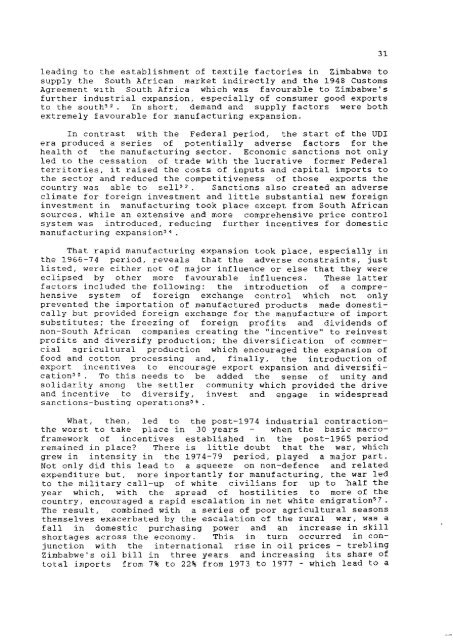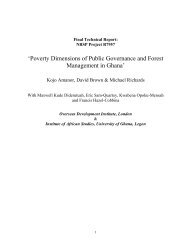Zimbabwe - Overseas Development Institute
Zimbabwe - Overseas Development Institute
Zimbabwe - Overseas Development Institute
Create successful ePaper yourself
Turn your PDF publications into a flip-book with our unique Google optimized e-Paper software.
leading to the establishment of t e x t i l e f a c t o r i e s i n <strong>Zimbabwe</strong> to<br />
supply the South A f r i c a n market i n d i r e c t l y and the 1948 Customs<br />
Agreement with South A f r i c a which was favourable to <strong>Zimbabwe</strong>'s<br />
f u r t h e r i n d u s t r i a l expansion, e s p e c i a l l y of consumer good exports<br />
to the south'2 . In short, demand and supply f a c t o r s were both<br />
extremely favourable f o r manufacturing expansion.<br />
In contrast with the Federal period, the s t a r t of the UDI<br />
era produced a s e r i e s of p o t e n t i a l l y adverse f a c t o r s f o r the<br />
health of the manufacturing sector. Economic sanctions not only<br />
l e d to the cessation of trade with the l u c r a t i v e former Federal<br />
t e r r i t o r i e s , i t r a i s e d the costs of inputs and c a p i t a l imports to<br />
the sector and reduced the competitiveness of those exports the<br />
country was able to s e l l " . Sanctions also created an adverse<br />
climate f o r f o r e i g n investment and l i t t l e s u b s t a n t i a l new f o r e i g n<br />
investment i n manufacturing took place except from South A f r i c a n<br />
sources, while an extensive and more comprehensive p r i c e c o n t r o l<br />
system was introduced, reducing f u r t h e r i n c e n t i v e s f o r domestic<br />
manufacturing expansion'".<br />
That r a p i d manufacturing expansion took place, e s p e c i a l l y i n<br />
the 1956-74 period, reveals that the adverse c o n s t r a i n t s , j u s t<br />
l i s t e d , were e i t h e r not of major i n f l u e n c e or else that they were<br />
e c l i p s e d by other more favourable i n f l u e n c e s . These l a t t e r<br />
f a c t o r s included the f o l l o w i n g : the i n t r o d u c t i o n of a comprehensive<br />
system of f o r e i g n exchange c o n t r o l which not only<br />
prevented the importation of manufactured products made domestic<br />
a l l y but provided f o r e i g n exchange f o r the manufacture of import<br />
s u b s t i t u t e s ; the f r e e z i n g of f o r e i g n p r o f i t s and dividends of<br />
non-South A f r i c a n companies c r e a t i n g the " i n c e n t i v e " to r e i n v e s t<br />
p r o f i t s and d i v e r s i f y production; the d i v e r s i f i c a t i o n of commerc<br />
i a l a g r i c u l t u r a l production which encouraged the expansion of<br />
food and cotton processing and, f i n a l l y , the i n t r o d u c t i o n of<br />
export i n c e n t i v e s to encourage export expansion and d i v e r s i f i <br />
c a t i o n " . To t h i s needs to be added the sense of u n i t y and<br />
s o l i d a r i t y among the s e t t l e r community which provided the drive<br />
and i n c e n t i v e to d i v e r s i f y , i n v e s t and engage i n widespread<br />
sanctions-busting operations''.<br />
What, then, led to the post-1974 i n d u s t r i a l c o n t r a c t i o n -<br />
the worst to take place i n 30 years - when the basic macroframework<br />
of i n c e n t i v e s e s t a b l i s h e d i n the post-1965 period<br />
remained i n place? There i s l i t t l e doubt that the war, which<br />
grew i n i n t e n s i t y i n the 1974-79 period, played a major part.<br />
Not only d i d t h i s lead to a squeeze on non-defence and r e l a t e d<br />
expenditure but, more importantly f o r manufacturing, the war led<br />
to the m i l i t a r y c a l l - u p of white c i v i l i a n s f o r up to Tialf the<br />
year which, with the spread of h o s t i l i t i e s to more of the<br />
country, encouraged a r a p i d e s c a l a t i o n i n net white emigration'?.<br />
The r e s u l t , combined with a s e r i e s of poor a g r i c u l t u r a l seasons<br />
themselves exacerbated by the e s c a l a t i o n of the r u r a l war, was a<br />
f a l l i n domestic purchasing power and an increase i n s k i l l<br />
shortages across the economy. This i n turn occurred i n conj<br />
u n c t i o n with the i n t e r n a t i o n a l r i s e i n o i l p r i c e s - t r e b l i n g<br />
<strong>Zimbabwe</strong>'s o i l b i l l i n three years and i n c r e a s i n g i t s share of<br />
t o t a l imports from 7% to 22% from 1973 to 1977 - which lead to a
















